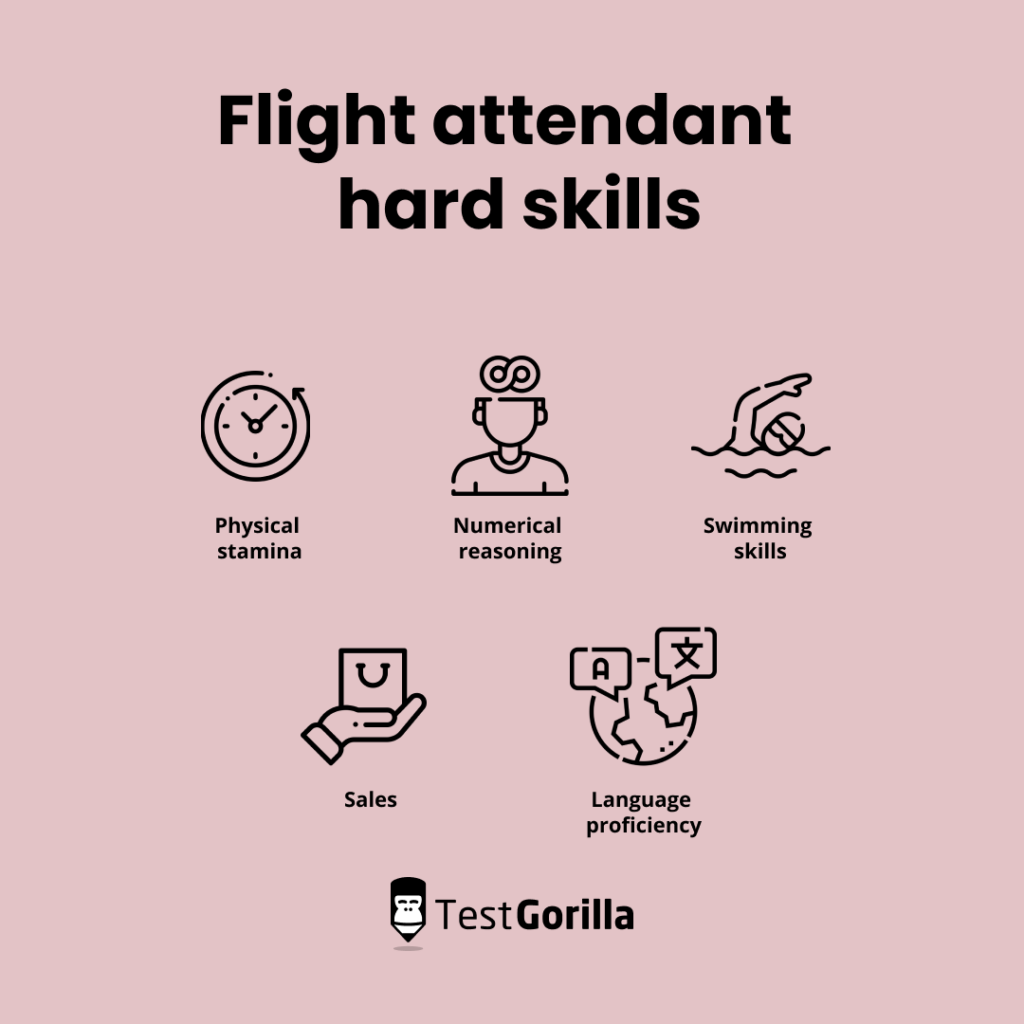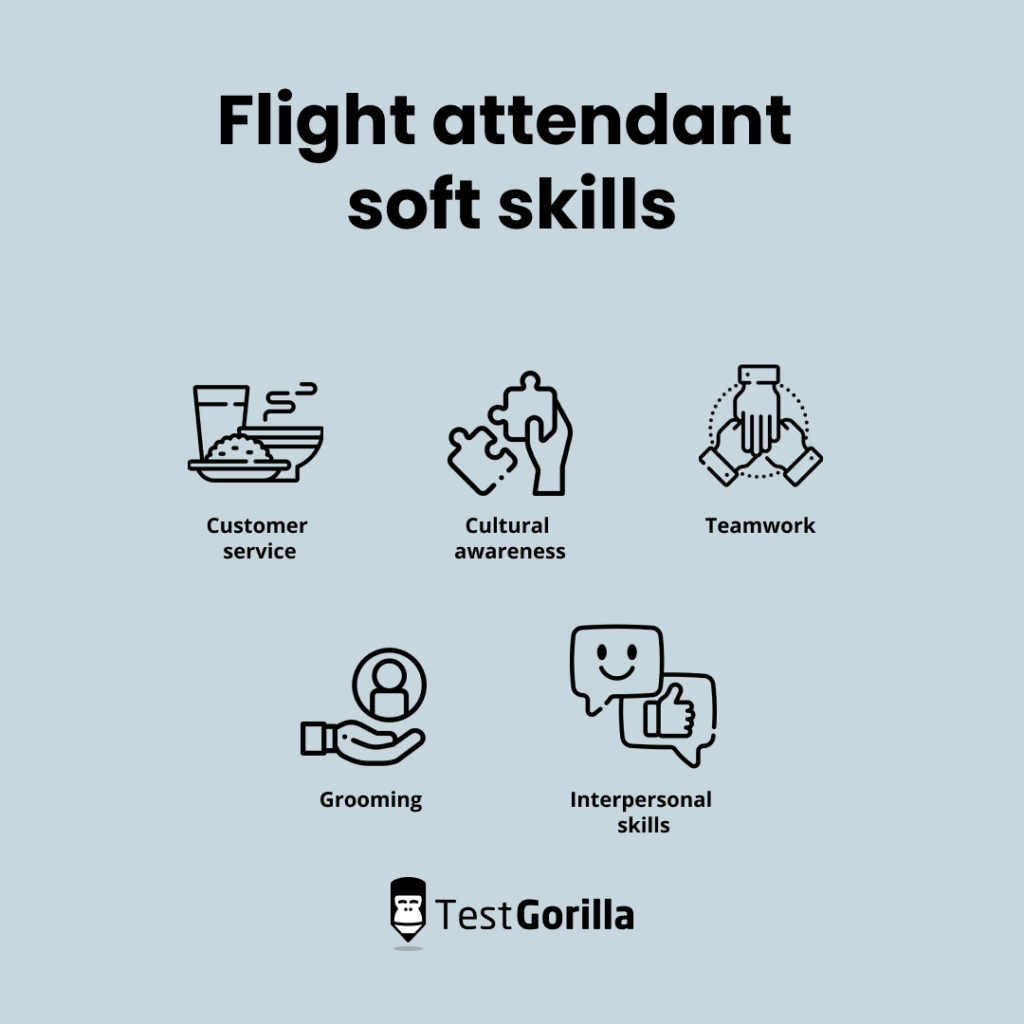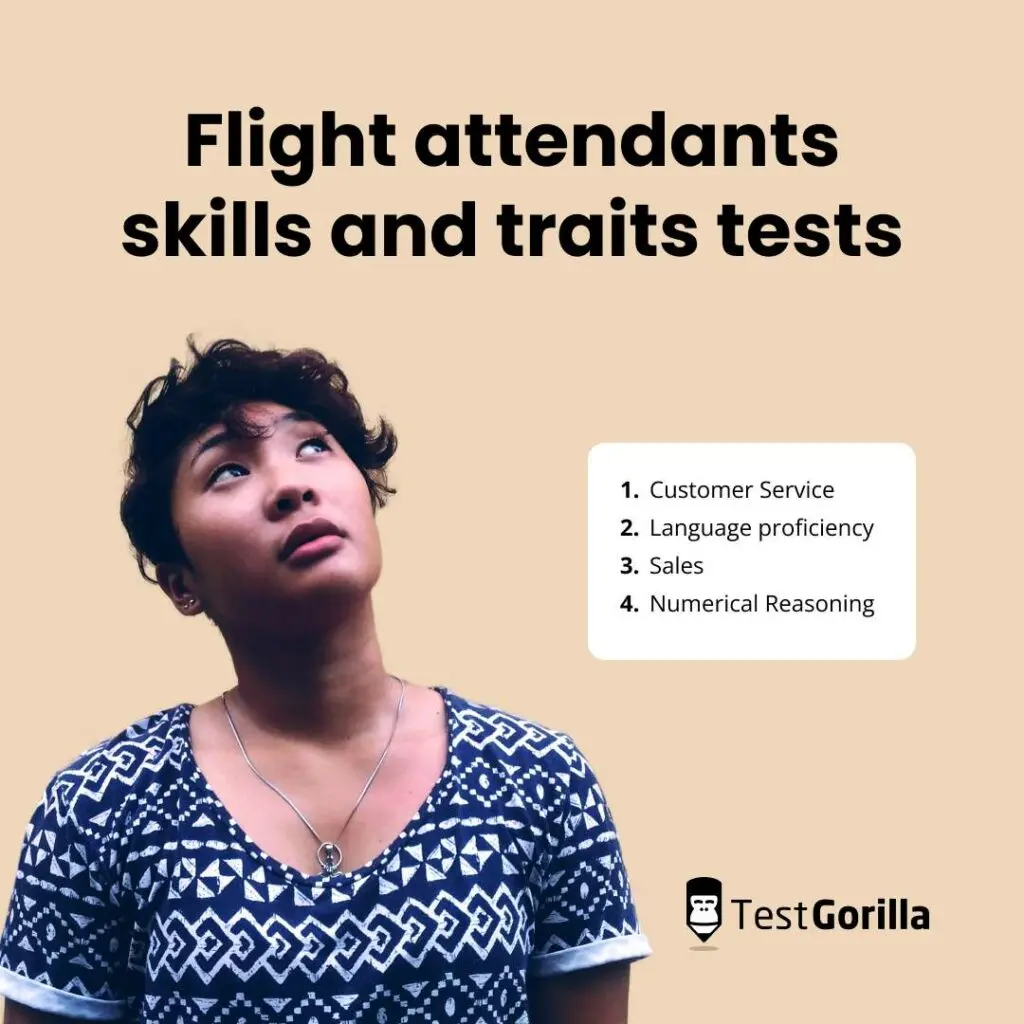To a large extent, flight attendants determine how successful an airline will be. They play a huge role in crafting a company’s image since passengers use them to rate the customer service an airline provides.
During recruitment, identifying flight attendants with top customer service skills is a step in the right direction. That’s because the primary role of flight attendants is attending to passengers before, during, and after the flight.
Hiring a flight attendant demands a keen eye for detail. You must know the traits, skills, and qualifications of a good flight attendant. Without the proper guidance, this might be a hassle.
Fortunately, this article explains how to hire a flight attendant in detail. We will describe what a flight attendant is, their essential skills, and how to draft a flight attendant job description.
Table of contents
- What is a flight attendant?
- What are the ranks of a flight attendant?
- Flight attendant hard skills
- Flight attendant soft skills
- How to test flight attendants’ skills
- Where to find flight attendants
- Tips for finding the perfect flight attendant
- Flight attendant job description template
- How much does a flight attendant cost?
- Flight attendant interview questions
- Hire your next flight attendant with TestGorilla
What is a flight attendant?
A flight attendant is a person who looks after passengers in an airplane. They ensure that the passengers are comfortable and provide assistance in situations where it is required. They are also responsible for serving passengers meals during flights.
Essentially, flight attendants spend more time with the passengers than any other cabin crew member. During this time, they offer each passenger the most personalized service possible during the flight.
Flight attendants may work in first-class or economy cabins. Either way, they perform very similar functions in either cabin. The only difference is that in economy, the flight attendants handle more passengers than in first class.
From briefing passengers about safety standards to showing them the closest emergency exit, flight attendants take on a lot of responsibility. And while doing their job, they develop trust with the passengers.
Furthermore, these airline stewards attend preflight meetings with the rest of the cabin crew to obtain information about each flight. They also stock the plane’s cabin with food and drinks before flights.
The job of a flight attendant demands that they have the passengers’ best interests at heart. Thus, they must ensure excellent customer service and the application of hospitality skills when taking care of passengers mid-flight.
What are the ranks of a flight attendant?
As flight attendants work with an airline, they receive promotions. The promotions progress along a system, with each rank having more expertise than the previous one. Here is the hierarchy of flight attendants:
1. Flight attendant
This is the starting point for every flight attendant. Before rising through the ranks, a flight attendant is responsible for basic things like monitoring passengers and stocking the cabin.
They go over safety protocols with passengers and answer any questions the customers have. Flight attendants also carry out preflight safety checks and assist passengers with boarding and exiting the plane.
2. Purser
The role of a purser includes reviewing flight information and sharing important passenger information with the captain. They also attend to passengers who need special assistance and address misbehaving ones.
Pursers earn a higher salary than flight attendants but have to undergo various training to become one.
3. Chief purser
Chief pursers are also referred to as in-flight managers. They report to the captain after the cabin is secure for takeoff and landing, and give onboarding announcements. Chief pursers also oversee pursers and flight attendants while managing the administrative tasks of the flight.
For a flight attendant to obtain the position of chief purser, they must have spent a minimum of 10 years of service in the airline. Apart from taking on more responsibilities than the others, chief pursers possess more certifications and experience.
Flight attendant hard skills
For flight attendants to function optimally, they must have skills such as stamina and numerical reasoning. Thus, to identify good flight attendants, you should consider the following hard skills:
1. Physical stamina
According to ExclusiveFlyers, flight attendants work an average of 12 to 14 hours a day. Since they spend a good amount of this time either walking or standing, they need adequate physical stamina.
The job of a flight attendant also comes with fluctuating work schedules and long working hours. Physical fitness is helpful, otherwise they might grow tired quickly and reduce their working efficiency.
Even when the plane is on the ground, there are many pre-boarding activities they must perform. These activities, such as ushering passengers to their seats and guiding them as they board the plane, require physical stamina.
Physical stamina makes flight attendants perform their tasks at a quicker pace with more agility. Hence, even in an emergency, they would be able to solve the problem efficiently without getting tired.
2. Numerical reasoning
During flights, the airlines might market various products and services to the passengers. As the passengers purchase these products, the flight attendants need numerical reasoning to keep track of the transactions.
Flight attendants with numerical reasoning can handle money while performing in-flight services. Numerical competence extends to ensuring they’ve added the totals correctly and given the right change in the right currency.
Numerical reasoning skills enable flight attendants to take note of how many passengers are on a flight. These skills also help them determine if they have enough food and drinks for each flight.
3. Swimming skills
Ditching is an emergency landing situation in which the airplane must land on water. During international flights, the aircraft usually goes over large bodies of water, although pilots try to avoid it.
While crash landing in the ocean is the worst-case scenario, flight attendants need basic swimming skills in such situations. Swimming skills are valuable when they have to help passengers in need, regardless of life vests being on the plane.
Flight attendants must be able to swim a distance of at least 27 to 54 yards without assistance from a floatation device. This is to ensure that the flight attendant has no issues when ditching.
4. Sales
Airlines use sales from food, beverages, and other products as a major source of revenue. To this effect, flight attendants must be able to market the airline’s products to the customer and secure sales.
Flight attendants with sales skills can give passengers the extra nudge they might need to decide to purchase products or services during the flight.
5. Language proficiency
The ability to speak and understand multiple languages is crucial for all flight attendants. This is because they interact with people from different parts of the world who speak other languages.
Statista records that in 2022, around 1.5 billion people spoke English. With this in mind, we can agree that the language is quite popular. However, flight attendants must understand other languages like Spanish, Italian, and Mandarin.
This gives them an edge when handling passengers who don’t speak English. With language proficiency, they can communicate better with foreign passengers to understand and solve their problems.
Flight attendant soft skills
Soft skills help flight attendants build relationships with passengers. This creates an environment where they can apply their technical skills and knowledge with a strategic approach.
Soft skills combine with hard skills to ensure that flight attendants deliver top-notch services. Thus, it is always best to look out for soft skills while hiring flight attendants. Below are some soft skills flight attendants need:
1. Customer service
It is the duty of the flight attendant to serve passengers. This involves serving food and beverages, and ensuring passengers’ comfort throughout the flight. So, to function in the role effectively, flight attendants must have good customer service skills.
Passengers usually rate the airline based on the quality of service they receive. Thus, customer service plays a prominent role in determining whether passengers are satisfied with the flight.
Flight attendants with the appropriate customer service skills ensure your passengers enjoy their trip. Ultimately, the quality of their service could determine if the customer returns to your airline or not.
2. Cultural awareness
People all over the world board flights. This means flight attendants meet people with different practices, customs, and races. Since these cultures differ from the flight attendants’, they must be aware of and respect passengers and their cultures.
Cultural awareness ensures flight attendants don’t do things that might come off as offensive to some passengers. It generally bolsters their service and allows the customers to enjoy the entire flight experience with no regrets.
Cultural awareness makes flight attendants sensitive to cultures and able to appropriately relate with passengers. Moreover, passengers appreciate flight attendants who know their culture’s intricacies.
3. Teamwork
Flight attendants are cabin crew members, so by design, their role requires them to work in teams. These teams could include three or more people depending on the kind of aircraft they’re working on.
A single flight attendant can’t do everything unless they render service on a small private jet. Additionally, flight attendants report to senior pursers and the captain, so they must know how to work in teams.
Therefore, teamwork enhances communication amongst themselves and improves productivity. At the end of the day, the team can work together to improve the passengers’ experience with the airline.
4. Grooming
Looks play a significant role across the airline business, though some airlines have stricter dressing policies than others.
For example, some airlines require that their flight attendants’ tattoos aren’t visible while wearing the flight attendant uniform. So face tattoos are generally not acceptable in the world of flight attendants.
Well-groomed flight attendants promote an excellent representation of the airline. They also influence the way passengers view the airline. Hence, flight attendants must know how to dress professionally and appropriately.
5. Interpersonal skills
Flight attendants constantly meet and work with different kinds of people. To navigate these relationships, they need amazing interpersonal skills.
Interpersonal skills help flight attendants be assertive when necessary and more empathetic in other instances. An example is when a first-time flier who might be anxious during the flight needs some assistance.
Here, the flight attendant can approach the passenger with a smile, offer help, listen to their concerns, and even share tips to help them calm down. Doing this effectively always stems from having great interpersonal skills, which allows flight attendants to perform exceptionally during the flight.
How to test flight attendants’ skills
Pre-employment tests are ideal for hiring flight attendants with the proper skill set you need. Essentially, these tests help you filter qualified candidates from the rest and spot talent easily.
The tests focus on evaluating how skilled candidates are rather than how many years of experience they have. Thus, they are a more effective way of hiring top-flight attendants.
With TestGorilla, you have access to numerous pre-employment tests that evaluate the various flight attendant skills. Below, we’ve described some of our pre-employment tests that can help you assess your candidates:
1. Customer Service test
Our Customer Service test examines how well applicants respond to customer issues. This test helps spot flight attendants who can take a customer-focused approach to solving problems and delivering services.
Primarily, this 10-minute test evaluates the applicant’s interaction with passengers, language, attitude, and problem-solving skills. Flight attendants who pass this test know how to put customers first and use customer service skills when handling passengers.
This skill also comes in handy when dealing with passengers that give flight attendants a hard time onboard. It helps them understand such passengers and respond appropriately without being rude or harsh.
2. Language proficiency test
In times of emergency, a lack of language proficiency could lead to miscommunication.
Fluency in multiple languages can help flight attendants communicate better and assist passengers where necessary.
To this effect, you must test for language proficiency during your recruitment. Here are some of the language proficiency tests TestGorilla provides:
English: English c1 proficiency test
Spanish: Spanish c1 proficiency test
French: French c1 proficiency test
Mandarin: Mandarin c1 proficiency test
When hiring a flight attendant, you can apply more than one of the tests mentioned above.
3. Sales test
This sales test assesses the candidate’s understanding of the selling process. It also evaluates their knowledge of the product they are selling and the customer they are selling to. With this, you’ll identify flight attendants with the right sales skills.
Applicants that perform well on this test have a firm understanding of transactional sales. In addition, they also have knowledge of product pitches, rapport building with passengers, and how to handle rejections.
This test is excellent for identifying applicants that can close deals and maintain good customer relationships. It also helps you spot those who can create awareness of the other products or services you provide.
4. Numerical Reasoning test
Our Numerical Reasoning test checks how well the candidates can work with numbers. It evaluates their ability to draw information from a set of numbers and apply that information to real-life scenarios.
Testing for numerical reasoning is essential because flight attendants deal with numbers. They need numerical skills to take note of how many people are on a flight to report to the captain in case of emergencies.
Candidates that pass the numerical reasoning test know the implication of numbers in real-life scenarios and can perform some technical analysis for the plane in flight.
Where to find flight attendants
Before deciding whether to hire a freelance or a full-time flight attendant, consider how often you expect the flight attendant to work. For example, if you have a flight on short notice as a private airline, freelance flight attendants are the better pick.
However, as a commercial airline that makes daily trips to all parts of the world, hiring full-time flight attendants is more cost-effective. Full-time flight attendants are also familiar with the protocols and guidelines of your airline, so they don’t need retraining.
Below we will explain what freelance and in-house flight attendants do, and the pros and cons of hiring them:
Full-time flight attendant
A full-time flight attendant works with a particular airline over a long period. Full-time flight attendants do not have a standard work schedule. This means they may work at night, on weekends, and even on holidays.
However, as flight attendants gain experience and seniority, they have more control over their schedules.
The following are some of the pros of hiring a full-time flight attendant:
They have a defined salary structure, so you can plan how much you spend retaining them.
You can assign them flights even in urgent situations.
They stay loyal to your company and adapt to your culture.
Here are the cons of hiring a full-time flight attendant:
The benefits added to their terms of employment are expensive to maintain.
It might be challenging to keep them motivated after they’ve worked months without a break.
Doing the same tasks every flight can lead to burnout.
Freelance flight attendant
Freelance flight attendants have more freedom when it comes to working hours. Since they work part-time, they usually have other jobs on the side. Freelance flight attendants are best suited for one-time flights since they work with multiple airlines.
In some airlines, freelance flight attendants work under the reserved status. This means they have to work their way up to become full-time flight attendants.
The pros of hiring a freelance flight attendant include:
You pay them according to how many hours they work. Thus, they are a cheaper alternative.
Often they don’t have access to work benefits, reducing their cost.
Since they work for various airlines, they are flexible and better at multitasking.
Below are the cons of hiring a freelance flight attendant:
They may not always be available when you need them.
They work for multiple companies and may not prioritize your airline.
Unlike full-time flight attendants, they aren’t loyal to one airline.
Here are some platforms where you can find both freelance and full-time flight attendants:
Tips for finding the perfect flight attendant
Finding excellent flight attendants might be challenging since it is quite a delicate job role. Regardless, here are some tips on how to spot a suitable flight attendant:
1. Put out an excellent job description
A good job description can attract the right kind of talent you need. For example, posting your job description online lets you reach potential applicants you could not have met in person, perhaps because they live on another continent.
An excellent job description can also prevent underqualified candidates from applying.
2. Search online recruitment websites
If you are looking to spot freelance flight attendants, this is a quick way to go about it. Certain recruitment websites specialize in helping you find freelance flight attendants while others focus on helping you hire for full-time roles.
So, before choosing to use a recruitment website, it’s best that you know which type of flight attendant you’re looking for.
3. Post the vacancy online
Another great way to find flight attendants is to post the job vacancy online. You can either do this by publishing the job posts on social media platforms or using paid ads.
Doing this raises awareness for the role, thus, expanding your applicant pool and giving you more candidates to select from. It also increases the chances of more qualified candidates applying to be flight attendants at your company.
Flight attendant job description template
Job description templates are reusable model templates tailored to specific role requirements, skill sets, responsibilities, and job duties. They help accelerate your recruitment process by reducing the time spent creating job descriptions from scratch.
These templates allow you to focus more on examining the applicants coming your way. Below is an example of a flight attendant job description template to guide your job description draft.
[JOB TITLE]
A job title is the name of the position the applicant will hold at your company if they get the role. Here you should state which title comes with the role. In essence, what kind of flight attendant are you looking to hire? For example:
“Chief flight attendant at [NAME OF INSTITUTION].”
[COMPANY INTRODUCTION]
In this section, you tell prospective applicants about your company, including your goals and values. This section draws the applicant in by giving them reasons to apply to your company.
“[COMPANY NAME] is an airline with over 80 years of involvement in the airline industry. We are looking for Europe-based flight attendants who can work effectively in a team and build good relationships with passengers.”
[JOB RESPONSIBILITIES]
In this section, you include the tasks that come with the role of a flight attendant. This gives the potential applicant an idea of what the role entails. For example:
“As the chief flight attendant at [COMPANY NAME], you will:
Ensure passenger safety and comfort during flights
Greet passengers, check their tickets, and show them their seats
Devote time during the flight to provide customers with hospitality
Assist passengers pre-flight with boarding and conduct safety emergency exit briefings
Monitor and assess the cabin regularly.”
[QUALIFICATIONS]
Here, you’ll state the level of qualification you expect from an ideal applicant. Qualification level and experience vary based on the type of flight attendant. Below is an example for chief flight attendants:
“To be right for this role, you must have:
At least a High School or General Education Development (GED) Diploma
Ability to speak, write, read, and understand the English language
Ability to speak and understand at least three languages asides from English
Completed the In-Flight Training Program
Completed 840 flight hours as a flight attendant
Current possession of a valid international passport.”
[SALARY AND BENEFITS]
In this section, you inform the prospective applicant of the benefits and salary that come with the role. It is best to state the incentives for the part clearly to encourage suitable applicants to apply. Below is an example:
“As the chief flight attendant at [COMPANY NAME], you’ll have access to the following:
401(k)
Health insurance
Paid time off
Bonus pay for overtime
Pay: $70,000 per year.”
[JOB COMMITMENTS]
Here you include the essential details of the job. This ranges from working schedules to COVID-19 restrictions. For example:
“This role requires that you work on holidays and wear masks while onboard the plane in line with the COVID-19 restrictions.”
How much does a flight attendant cost?
According to Comparably, flight attendants in the United States earn an average of $52,153 annually. However, salary largely depends on factors such as education level, certifications, years of experience as a flight attendant, and additional skills.
Hence, there aren’t set salaries for flight attendants. It all depends on what kind of flight attendant you want and the service you want them to give. For example, the quality of service in a private plane differs from that in commercial airplanes.
Here are some of the salaries of different types of flight attendants:
Corporate flight attendants earn about $46,247 annually
Private airline flight attendants make around $50,000 per year
International flight attendants, on average, earn about $46,000 annually
Flight attendant interview questions
Preparing interview questions before the interview allows you to identify what criteria you’d like to be met. Consequently, identifying the requirements lets you channel your energy into asking relevant questions about the role.
By preparing interview questions beforehand, you ensure asking the right ones. Thus, it’s easier to select the best applicants for the role during the interview stage.
The challenge here might be, “What questions should you ask to help spot the best candidate for this role?” In response, we have come up with several interview questions you can ask potential flight attendants:
What field experience do you have for this role?
Why did you become a flight attendant?
Why do you want to work for our airline?
What was your favorite flight experience?
What are your customer service strengths?
How do you handle a scared passenger that has started panicking?
If a child passenger was traveling alone, what would you do?
The primary job requirement for flight attendants is to ensure passengers are safe, comfortable, and enjoy their flight experience. So, you can also include customer service interview questions to see how well the candidates can handle customers.
Hire your next flight attendant with TestGorilla
Hiring the right fight attendant requires that you have a solid recruitment plan. This recruitment plan should include potential interview questions, a good job description, and skills to look out for.
However, the recruitment plan isn’t complete without a pre-employment test. TestGorilla’s pre-employment tests evaluate the applicants on various flight attendant skills so you can spot the best without stress.
Our pre-employment tests are a sure way to ease up your recruitment and eradicate hiring bias. Get started for free today with TestGorilla to experience a stress-free recruitment process.
Related posts
Hire the best candidates with TestGorilla
Create pre-employment assessments in minutes to screen candidates, save time, and hire the best talent.
Latest posts
The best advice in pre-employment testing, in your inbox.
No spam. Unsubscribe at any time.

Hire the best. No bias. No stress.
Our screening tests identify the best candidates and make your hiring decisions faster, easier, and bias-free.
Free resources
This checklist covers key features you should look for when choosing a skills testing platform
This resource will help you develop an onboarding checklist for new hires.
How to assess your candidates' attention to detail.
Learn how to get human resources certified through HRCI or SHRM.
Learn how you can improve the level of talent at your company.
Learn how CapitalT reduced hiring bias with online skills assessments.
Learn how to make the resume process more efficient and more effective.
Improve your hiring strategy with these 7 critical recruitment metrics.
Learn how Sukhi decreased time spent reviewing resumes by 83%!
Hire more efficiently with these hacks that 99% of recruiters aren't using.
Make a business case for diversity and inclusion initiatives with this data.




















